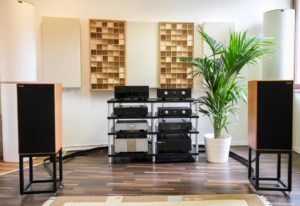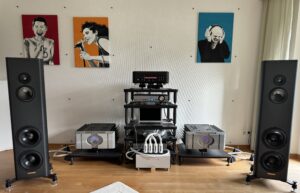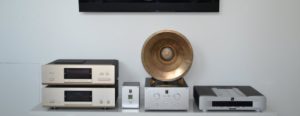"Today I put the Schnerzinger GRID PROTECTOR into permanent operation here.
I already had the opportunity to try Schnerzinger products here for an afternoon some time ago. Only at that time, as many Schnerzinger products as possible should be demonstrated and the listening test was carried out primarily with CD. Even then, the GRID PROTECTOR impressed me most positively! That's why I decided to purchase one here for our reference system.
The scope of supply includes the GRID PROTECTOR itself - with the power cord connected and marked for proper phasing. A small cylinder, called a control unit, which is connected to a specific input of the GRID PROTECTOR. A small plug-in power supply unit is connected to this cylinder with the supplied cables.
On the GRID PROTECTOR itself, there are a total of 9 switches: a two-stage switch selects: Lowest power (LED's off), Medium power (LED's on, but dimmed), Full power (LED's on, very bright). 4 switches each are for bandwidth and clock rate. At first tests I got the best results with medium power and bandwidth and clock rate each 3 out of 4.
So what does this device do sonically?
I myself have some experience with mains filtering and mains conditioning - both in audio and in measurement technology. My impression: results like from very good mains filtering:
- less noise, i.e. hiss and masking effects
- thus more details, better spatial representation
- Instruments & voices are more precise, better delineated from each other
- the dynamics improve
Such effects are sometimes caused by additional distortions, e.g. when an amplifier stage in the chain is overdriven. After a short time of enthusiasm, it is then simply annoying after a short time!
That's why the "acid test" for me is whether the naturalness and emotionality also increase with the above-mentioned points. Only then is it a real improvement.
The Schnerzinger GRID PROTECTOR does this perfectly!
When it comes to something like spatiality, delineation of instruments, I like to use Pink Floyd's 'Dark Side of the Moon'. I know this record very well and especially I know very well how it was recorded.
With the first 3 pieces there the Leslie and/or the Leslie produced with the synthesizer and mixer is quite meaningful, just like the runner in the dispatch hall. With such well-known pieces I have here with the Schnerzinger GRID PROTECTOR a clear increase in the overall playback quality.
For the question of naturalness and emotionality I use Rickie Lee Jones 'Pirates' and Keith Jarett 'The Cologne Concert': a clear increase here too and of course in a very positive sense!
I have the device not yet long in operation and can certainly still optimize the setting in the long run! Some changes are not immediately audible, but need some time to take effect. Also what placement and the choice of the power outlet to which I connect the GRID PROTECTOR, must still be tried out exactly.
What's really amazing about the whole thing, by the way:
My entire power supply is quite sophisticated. Everything very elaborately filtered and decoupled from each other. Nevertheless, the GRID PROTECTOR works but clearly traceable! This means for me: It is not a conventional, technically known way of filtering / noise reduction, but something completely new!
What about the price/performance ratio: The device costs €3800. I find the price quite justified. With other upgrades - e.g. cables, component replacement, you very often don't get as far with the same financial investment.
So for higher-quality stereo systems a clear recommendation from my side!
What I have to admit: I have (still!) no idea how the device works technically. Since I am now times very curious, there will be a very, very detailed metrological investigation in the near future.
But I have to disappoint all those who hope for a publication of the results: If and what I find out, I will keep to myself - if only out of fairness to the manufacturer, who after all has created something extraordinary!
(Stephan G. – GECOM TECH 11/2021)







